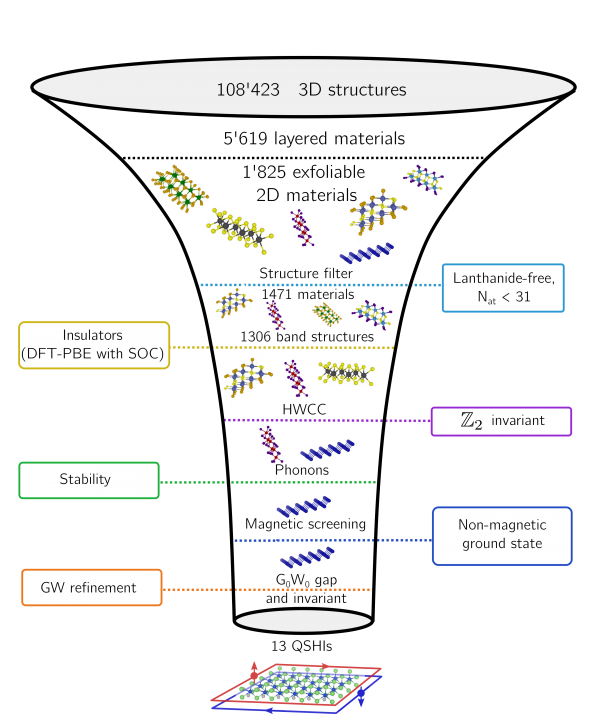Researchers identify 13 monolayers as potentially promising quantum spin Hall insulator candidates
By Carey Sargent, NCCR MARVEL, EPFL
Quantum spin Hall insulators (QSHIs) form a class of two-dimensional material with a finite electronic band gap in the bulk, but gapless helical edge states. As a result, though the surfaces of such materials contain conducting states, they act as insulators in their interiors—electrons can only move along the surface of the material. Some of the phenomena that can be hosted in these materials, from one-dimensional low-dissipation electronic transport to spin filtering, could be promising for many technological applications in the fields of electronics, spintronics, and topological quantum computing, but identifying them has proven difficult. The rarity of two-dimensional materials exhibiting such properties at room temperature hinders development.

Figure 1: The computational protocol for the screening of quantum spin Hall insulators (QSHIs) exfoliable from experimentally known crystalline compounds.
While a number of three-dimensional topological insulators have been predicted and experimentally confirmed, very few two-dimensional counterparts, these QSHIs, have been identified. Indeed, 1T′-WTe2 is the only experimentally confirmed monolayer crystal hosting a robust QSHI phase up to 100 k. Building on an earlier paper in which researchers from the same group identified 1825 2D materials as easily or potentially exfoliable from their layered 3D parent crystals, the scientists have now systematically explored those same compounds, searching for more QSHIs.
Their approach involved first selecting a set of computable properties that can define good QSHI candidates. In particular, they searched for materials that are mechanically stable, that have a finite electronic band gap, a nonmagnetic ground state, and a nontrivial Z2 topological invariant.
“Getting an overview of the relative abundance of these materials in nature is interesting in itself, but the work can also inspire the design of novel materials. Looking at these structures as they occur in nature gives us ideas about how to make materials that are similar, just more efficient.”
--Antimo Marrazzo
They took a computational high-throughput funnel approach, meaning that they first computed quantities requiring fewer computational resources for the larger pool of structures, while computing more demanding properties only for the progressively smaller sets of promising candidate materials.
Given the manageable number of materials considered, the researchers explicitly computed all properties using first principles quantum mechanical simulations. Using density-functional and many-body perturbation theory simulations, they ultimately identified 13 monolayers as dynamically stable and easily or at least potentially exfoliable QSHIs. Overall, the screening suggests a relative abundance of Z2 topological order in two-dimensional insulators of around 1%.
“Getting an overview of the relative abundance of these materials in nature is interesting in itself, but the work can also inspire the design of novel materials,” said Antimo Marrazzo, a doctoral student in the EPFL’s Laboratory of theory and simulation of materials. “Looking at these structures as they occur in nature gives us ideas about how to make materials that are similar, just more efficient.”
The researchers identified several compounds that have already been predicted as QSHIs (e.g., TaRhTe4 or TiNI) and, in a few cases, also confirmed with experiments (Bi, WTe2), validating the approach. They also found several novel candidates, including promising high-performance materials such as AsCuLi2, Pd2HgSe3 (palladium jacutingaite) and inspiring novel prototypes such In2ZnS4.
“Experimentalists have already started to work with jacutingaite (Pt2HgSe3 and Pd2HgSe3) and have obtained fantastic results," Marrazzo said. "The next step is to explore the rest of our list with them."
All the relevant data on the proposed materials are available on the Materials Cloud platform at https://materialscloud.org/discover/2dtopo/. Optimized crystal structures, electronic bands, phonons, and other properties can be downloaded and accessed interactively through the browser.
Reference: Relative Abundance of Z2 Topological Order in Exfoliable Two-Dimensional Insulators, Antimo Marrazzo, Marco Gibertini, Davide Campi, Nicolas Mounet and Nicola Marzari, https://doi.org/10.1021/acs.nanolett.9b02689
Low-volume newsletters, targeted to the scientific and industrial communities.
Subscribe to our newsletter